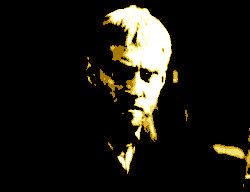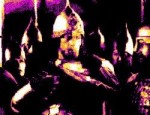Film Review
Director Benjamin Christensen followed his noteworthy debut feature
The
Mysterious X (a.k.a.
Sealed Orders) (1914) with this similarly
well-crafted thriller, one that feels eerily ahead of its time and is an
obvious precursor to the modern suspense-horror film. Originally released
in Christensen's native Denmark as
Hævnens nat,
Blind Justice
abounds with Hitchcockian tropes and surpasses virtually every other crime
melodrama of its time, including those immensely popular crime serials by
Louis Feuillade which it vaguely resembles in a few scenes. Today,
Christensen's reputation rests mainly on his subsequent
Häxan, Witchcraft
Through the Ages (1922), one of the most inspired and idiosyncratic
films of the silent era, but his earlier films are just as worthy of acclaim
and it is a tragedy that the director was unable to build on this early promise
after his move to UFA and then Hollywood in the mid-1920s. Anyone who
has watched Christensen's first three films could easily make a case for
ranking him alongside those cinematic titans D.W. Griffith and Abel Gance,
but were it not for
Häxan, his greatest accomplishment, his name
would long since have been lost to posterity.
Blind Justice takes a penny dreadful scenario that would have been
familiar to devotees of the
Perils of Pauline (1914) serial and develops
it into a full-blown psychological melodrama-cum-thriller that is as sophisticated
on the narrative front as it is with its use of cinematic visuals.
The characters are more fully developed than you could ever hope to find
in your average film thriller of this époque and this allows the contrived
plot to attain some measure of plausibility (even if it goes slightly off
the rails towards the end). The film is also an effective piece of
social satire, condemning society's willingness to judge others and allow
prejudice to triumph over compassion. The central theme, that things
are seldom how they seem, is sarcastically underlined in a scene in which
a baby in its crib is revealed to have a monkey's face. The shock is
momentary but deeply felt and lingers even when the camera retracts to reveal
that what we have in fact witnessed is merely a puppet show put on by two
doting parents for the amusement of their children.
This mischievous aside is a wry echo of the first shocker that Christensen
subjects us to near the start of his film. Realising she is trapped
in her bedroom, the heroine can only watch in excruciating terror as
something
heads towards her. The camera slowly pulls back from her visibly terrified
form, miraculously dissolving through a latticed window so that she now appears
trapped, entirely at the mercy of the shadowy form that is about to clamber
through the window, a night fiend intent on devouring its next prey.
The feeling of confinement and abject terror is palpable and brilliantly
sustained, not doubt influencing Murnau for his vampire offering
Nosferatu
(1922) and just about every other director in the horror genre since.
As in the puppet show, the fear is quickly shown to be unjustified.
Like the heroine, we have allowed our imagination to run away with itself.
It is only in the film's dramatic final reel that the threat acquires substance,
but by this time what could justifiably have been a descent into slasher-style
excess more resembles Greek tragedy, for now we see things from both perspectives
- the heroine almost welcoming retribution for her betrayal of an innocent
man, and the persecuted victim driven to revenge by a truly terrible sequence
of events.
It is startling how strongly
Blind Justice foreshadows subsequent
horror films, in particular James Whale's
Frankenstein (1931).
In place of the physically deformed monstrosity we have a man of powerful
physique (a circus strongman sympathetically played by Benjamin Christensen
himself) who has the misfortune of being wrongly convicted of a crime he
did not commit (just one of many Hitchcockian associations the film offers).
As a convicted criminal, the protagonist becomes
persona non grata
and then a murderous fiend - he is indeed judged blindly by a society that
needs easy scapegoats to maintain the illusion of order and respectability.
In the film's most poignant scene, the former strongman, now reduced to a
pathetic wreck of a man after realising that his son is lost forever,
is befriended by a child in a park. It is a scene that is reminiscent of
the one in
Frankenstein where the Monster makes friends with a little
girl. Both scenes end in disaster, with the protagonist realising that
his estrangement from humanity is total and irreversible. The timeless
moral is the one that underpins Mary Shelley's gothic novel. Society
creates the monster that is formed from the thing it rejects.
Although it is quite a substantial piece for its time (it runs to just over
100 minutes),
Blind Justice wastes not a second and runs through its
sequence of interweaving plots at a brisk pace without ever seeming to tread
water or become muddled. In purely narrative terms, the film is ahead
of its time, but what sets it apart is its confident and effective use of
various cinematic techniques which were only just being developed but which
have since become an essential part of the language of cinema. Christensen's
shot composition (note the immaculate and deliberate framings) and use of
cross-cutting add much to the film's relentless pace and oppressive mood.
Superimposition, camera movement and flashbacks are used to reveal
the mental states of the characters, predating the French impressionists
by almost a decade. The camera is not a static viewing instrument -
it acquires a character of its own, providing a subjective viewpoint that
cannot be relied upon to show us the truth. That we are meant to be
voyeurs is stressed in the sequence where we are forced to peep through a
keyhole - we almost relish the heroine's descent into terror, anticipating
the violent encounter that is assuredly wending its way towards us.
By the film's thrilling climax, in which atonement, revenge and desperate
rescue thrash it out in a bubbling cauldron of melodramatic excess, Christensen
ekes out as much tension as he can as the drama surges towards its nail-blinding
conclusion. Shock tactics are used with gay abandon, gratifying our
lust for the ludicrously sensational. In one shot, the vindictive protagonist
suddenly appears at a window pane (a device that would become a trademark
of Mario Brava in such films as
Black Sabbath (1963)).
In another, the same would-be killer rushes in from the side of the frame
to attack the unwary heroine - a cheap but effective 'knock 'em out of their
seats' tactic used by Hitchcock in
Psycho
(1960), John Carpenter in
Halloween
(1978) and countless other directors since. With the heroine now well
and truly tied to the railway tracks (metaphorically speaking), the action
cuts back and forth between her and her rescuers, who exercise every ounce
of ingenuity to get themselves out of their own dire predicament. Everything
plays out with mechanical predictability but Christensen keeps us hooked
and delivers a denouement every bit as tense and exciting as anything you
will find in today's Hollywood action blockbusters.
© James Travers 2016
The above content is owned by frenchfilms.org and must not be copied.



